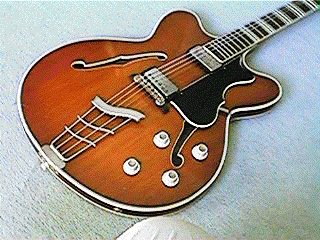Dream come true

Every guitar player’s dream is to walk into an old house and find, hidden somewhere in the attic or basement, an old but valuable guitar. The owner, who would be an old but charming lady, would be completely clueless as to the value of the guitar, it having been left behind by her dear husband who died years ago. “That old thing!” she would say. “My husband used to play it every night instead of talking to me. I always hated it! You can have it if you want.”
That dream just became a reality to me, although it’s not an old house I walked into but the shop of a guitar builder here in
I first saw it last year lying in one corner of the shop, covered with dust, ignored by p eople who probably were unaware that an old piece of wood like that would be worth anything. It had no hardware – no tuning keys, bridge, pickups, tone controls – but its shape caught my eye: it was double horned archtop, with two f-holes, very thin, and very old by the looks of it. I cleaned it with a rag and saw in its headstock that it was a Hofner, but I was dismayed because a portion of the back had already become unglued. Jingo, however, assured me it was easy to repair; besides, the rest of the guitar was solid and could be restored.
eople who probably were unaware that an old piece of wood like that would be worth anything. It had no hardware – no tuning keys, bridge, pickups, tone controls – but its shape caught my eye: it was double horned archtop, with two f-holes, very thin, and very old by the looks of it. I cleaned it with a rag and saw in its headstock that it was a Hofner, but I was dismayed because a portion of the back had already become unglued. Jingo, however, assured me it was easy to repair; besides, the rest of the guitar was solid and could be restored.
When I got back home I logged on to the Hofner website and found that the model it most closely resembled was the Verythin Standard. There were significant differences, however: the Verythin Standard has a tune-o-matic bridge similar to a Les Paul’s, whereas the gui tar I found did not have the holes necessary to install such a bridge system (which meant it sported a tailpiece). The fretboard markers were also different: the guitar in Jingo’s shop had pearl inlays laid out in strips, whereas the Verythin Standard had more modern-looking dots.
tar I found did not have the holes necessary to install such a bridge system (which meant it sported a tailpiece). The fretboard markers were also different: the guitar in Jingo’s shop had pearl inlays laid out in strips, whereas the Verythin Standard had more modern-looking dots.
I thus surmised that the guitar I found was the original model, produced (according to the website) in 1960, so I searched for it in the net. After some misses I finally found a site that showed what the original model looked like. It turns out that the original was called Verithin (with an “i” instead of a “y”), and it has since been updated by Hofner to a more modern look that is more appealing to new players (mainly by losing the archtop style metal tailpiece in favor of the tune-o-matic style). But the original model is lovely in its own right (just take a look at the photo at the beginning of this entry), and for someone like me who has always dreamed of owning a vintage guitar but could never afford one, it was indeed a dream come true to find one that’s within my means.
Jingo and I will work on the Verithin over the next few months. A friend of mine is bringing in some good tuners and a proper archtop bridge from the
I am excited about this project, and I will keep you posted on our progress until we finally complete the guitar. If we do it right, the Verithin will probably become my main guitar.




0 Comments:
Post a Comment
<< Home